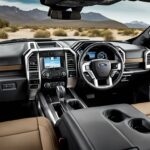Speed-Compensated Volume Control is essential for enhancing your auditory experience on the road. This innovative feature adjusts the audio output in response to changes in vehicle speed, ensuring ideal sound quality regardless of external noise levels.
Key Points
- Speed-compensated volume adjusts audio based on vehicle speed for optimal sound quality.
- Dynamic volume adjustment reduces distractions and offers customized sound levels.
- Implement audio level automation for seamless listening experiences tailored to preferences.
- Enhance audio clarity by utilizing soundproofing materials, speaker upgrades, and optimized settings.
- Customize volume profiles for driving conditions to ensure consistent and enjoyable audio experiences.
Understanding Speed-Compensated Volume

By incorporating speed control into volume adjustments, the system counteracts any disturbances, providing a seamless listening experience. Users have the flexibility to customize their preferences, fine-tuning the sound optimization to suit their individual requirements. Some enthusiasts even liken the impact of Speed-Compensated Volume Control to that of a preamp, elevating the audio output to new levels of clarity and richness.
The practicality of this feature may vary depending on the type of vehicle and any modifications made to the audio system. Engaging in community discussions can offer valuable insights into optimizing settings and sharing user experiences, enabling you to make the most of this advanced technology on your daily drives.
Benefits of Dynamic Volume Adjustment
Dynamic volume adjustment maximizes your in-car audio experience by intelligently adapting sound levels to suit changing driving conditions. This feature offers several benefits tailored to enhance your enjoyment of music on the road:
- Customized Sound Levels: Enjoy personalized volume adjustments based on your preferences, ensuring a perfect listening experience.
- Noise Reduction: Experience decreased distractions from external factors like wind noise or road sounds, allowing you to focus on your music.
- Smooth Shifts: Seamlessly move between different driving environments without needing manual adjustments, maintaining a consistent audio experience.
- Improved Audio Quality: Benefit from enhanced sound quality, especially on long road trips, where varying conditions can impact audio performance.
- Adaptability to Music Genres: Automatically adjust volume levels to suit different music genres and your specific music preferences, ensuring each song sounds its best.
Dynamic volume adjustment caters to your road trip playlists and music preferences, creating a personalized and immersive audio experience during your travels.
Implementing Audio Level Automation

By implementing audio level automation, users can optimize their in-car audio experience through precise adjustments based on vehicle speed to counteract external noise factors. Automating audio levels allows for a seamless listening experience by dynamically adapting to changing conditions.
Personalized settings enable users to tailor the volume adjustments to their preferences, ensuring that the audio remains clear and consistent regardless of the driving environment. This feature not only enhances the overall quality of sound reproduction but also reduces the need for manual intervention, allowing drivers to focus on the road ahead.
Customization options empower users to fine-tune the degree of volume control according to their specific driving habits and audio preferences. Speed-compensated volume control, when implemented effectively, can greatly improve the performance of the sound system, creating a more enjoyable and tailored audio experience for passengers.
Enhancing Audio Clarity on the Go
To further optimize your in-car audio experience, contemplate methods for enhancing audio clarity on the go, ensuring that your sound system delivers exceptional performance regardless of external factors. When looking to improve music quality and reduce road noise interference, here are some strategies to ponder:
- Soundproofing: Adding soundproofing materials to your car can help diminish external noise and vibrations, allowing your audio system to produce clearer sound.
- Upgrading Speakers: Investing in high-quality speakers can greatly enhance audio clarity, providing a richer listening experience even in noisy environments.
- Tuning Equalizer Settings: Adjusting your equalizer settings to match your vehicle’s acoustics can enhance sound quality and compensate for any deficiencies in your audio system.
- Installing Noise-Canceling Technology: Consider incorporating noise-canceling devices or systems to actively reduce unwanted sounds and background noise, further enhancing your listening experience.
- Optimizing Audio Placement: Properly positioning your speakers within the car cabin can help distribute sound evenly and minimize distortion, resulting in improved audio clarity on the go.
Optimizing Sound Quality at Speed
When aiming to optimize sound quality at speed in your vehicle, consider adjusting the speed-compensated volume control to guarantee a balanced audio experience even amidst varying road conditions. The speed-adjusted volume feature dynamically modifies the audio output based on your vehicle’s velocity, counteracting external noise factors like wind and road sounds.
By fine-tuning the speed adjustments, you can assure a consistent and pleasant listening experience regardless of how fast you’re driving. This sound optimization technique acts almost like a preamp, boosting audio levels to counter any limitations from the factory amplifier. Keep in mind that the effectiveness of this feature can differ depending on your vehicle’s make, model, modifications, and your personal sound preferences.
To truly optimize sound quality at speed, explore different settings, consult online forums, and engage with the community to gather insights and tips for maximizing the potential of your speed-compensated volume control.
Customizing Volume Profiles for Driving
Customize your volume profiles for driving by adjusting the speed-compensated volume control to suit different driving conditions and enhance your audio experience. Personalized settings allow you to tailor the audio output to your liking, guaranteeing that your audio preferences are met regardless of the driving environment.
Here are some tips for optimizing your volume profiles:
- Make speed sensitive adjustments to maintain a consistent audio level as you drive, enhancing your overall driving comfort.
- Fine-tune volume settings for various driving conditions to ensure an enjoyable listening experience.
- Utilize sync settings to synchronize your volume profiles across different driving scenarios, providing a smooth shift.
- Experiment with minimum settings to keep audio levels steady, or try maximum settings for a more immersive sound experience at higher speeds.
- Customizing volume profiles not only helps you maintain preferred audio levels but also contributes to an enhanced driving experience, making your time on the road more enjoyable.
Overcoming Challenges With Road Noise
In combating road noise challenges, optimizing your speed-compensated volume control settings can greatly enhance your driving audio experience. Noise cancellation becomes essential in this scenario, as it helps to counteract the unwanted sounds from the road, allowing for a more immersive audio environment within your vehicle.
By fine-tuning these settings, you can achieve a personalized audio immersion that maintains your preferred sound levels despite external distractions. Think of this feature as a way to create a shield of sound around you, much like a preamp enhances the performance of your sound system.
It’s important to note that the effectiveness of these adjustments may vary depending on your vehicle type and any modifications it may have. Remember to set different preferences for various driving conditions to optimize your audio experience fully.
Mastering these settings won’t only improve your audio quality but also make your driving experience more enjoyable and tailored to your preferences.
Is Speed-Compensated Volume a Feature in Two-Seater Sports Cars?
Yes, speed-compensated volume is a common feature in top two-seater sports cars. This feature automatically adjusts the volume of the audio system based on the car’s speed, ensuring optimal sound quality regardless of how fast you’re driving. It’s a convenient and practical feature for sports car enthusiasts.
Future Innovations in Audio Technology
Exploring the forefront of audio technology, cutting-edge advancements are paving the way for a transformative audio experience within vehicles.
- Advanced noise cancellation systems: Future innovations may include sophisticated noise cancellation technologies that enhance audio clarity by minimizing external disturbances.
- Smart audio systems with AI: Utilizing AI algorithms, audio systems could personalize sound settings to cater to individual preferences and adapt to changing driving conditions.
- Biometric sensor integration: Integration of biometric sensors in vehicles might enable audio systems to adjust volume and equalizer settings based on the driver’s stress levels or mood, creating personalized soundscapes.
- Holographic audio technology: The introduction of holographic audio could revolutionize in-car audio experiences by immersing listeners in a 3D sound environment, offering truly immersive audio experiences.
- Collaborations for spatial audio: Collaborations between automotive and audio companies could lead to innovative spatial audio systems that provide enhanced realism in music playback, delivering an unparalleled audio journey for drivers and passengers alike.
Frequently Asked Questions
How Does Speed-Compensated Volume Adjustment Differ From Traditional Volume Control Systems in Vehicles?
Speed-compensated volume adjustment differs from traditional systems by automatically adjusting audio levels based on vehicle speed, ensuring sound precision regardless of external noise. Speaker placement optimizes acoustic environment for consistent audio response, enhancing your driving experience.
Can Dynamic Volume Adjustment Help Reduce Distractions While Driving?
When driving, dynamic volume adjustment can boost driver focus by reducing distractions. The feature minimizes noise distractions, enhancing audio immersion. This results in a safer driving experience, as it automatically adjusts audio levels to match driving conditions.
Are There Specific Types of Road Noise That Can Be Particularly Challenging to Overcome When Optimizing Sound Quality at Speed?
When driving, road surface plays a pivotal role in sound quality. Wind noise, engine, and tire noise are common culprits. High-speed wind noise can be tough to beat due to its intensity. Tire noise, especially on rough roads, can muddle audio clarity at speed.
What Are Some Potential Drawbacks or Limitations of Implementing Audio Level Automation in a Vehicle?
When using audio level automation in your vehicle, you may encounter limitations such as subtle volume adjustments, varying effectiveness based on car model, and differences in behavior across brands. These drawbacks can impact user satisfaction and experience.
How Do Advancements in Audio Technology Contribute to Improving the Overall Driving Experience Beyond Just Volume Adjustment?
Advancements in audio technology enhance your driving experience by providing immersive sound customization. This improves audio immersion, driving safety, and overall user experience. Tailoring audio levels to your preferences creates a more enjoyable and safer journey.
As an Amazon Associate we earn from qualifying purchases.










